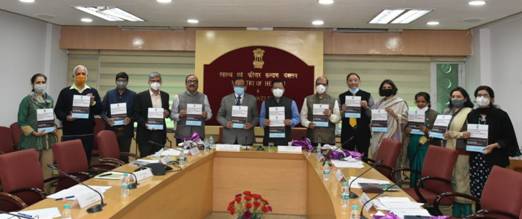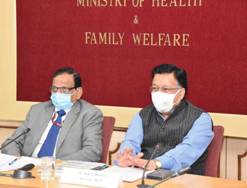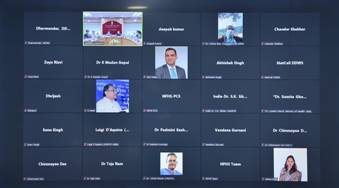Ministry of Health and Family Welfare
Union Health Ministry releases NFHS-5 Phase II Findings
“NFHS-5 shows Momentum towards achieving SDG is getting further accelerated”: Member (Health), NITI Aayog
“Data from NFHS will be beneficial to all line ministries, State Govts and other stakeholders”: Union Health Secretary
Posted On:
24 NOV 2021 1:50PM by PIB Delhi
Dr. Vinod Kumar Paul, Member (Health), NITI Aayog and Shri Rajesh Bhushan,Secretary, Union Ministry of Health and FamilyWelfare, Government of India, released the Factsheets of key indicators onpopulation, reproductive and child health, family welfare, nutrition and others forIndia and 14 States/UTs (clubbed under Phase-II) of the 2019-21 National Family Health Survey (NFHS-5) here today.

The States and UTs which were surveyed in the Phase-II are Arunachal Pradesh, Chandigarh, Chhattisgarh, Haryana, Jharkhand, Madhya Pradesh, NCT of Delhi, Odisha, Puducherry, Punjab, Rajasthan, Tamil Nadu, Uttar Pradesh andUttarakhand. The findings of NFHS-5 in respect of 22 States & UTs covered in Phase-I were released in December, 2020.
The main objective of successive rounds of the NFHS is to provide reliableand comparable data relating to health and family welfare and other emerging issues. The NFHS-5 survey work has been conducted in around 6.1 lakh samplehouseholds from 707 districts (as on March, 2017) of the country; covering724,115 women and 101,839 men to provide disaggregated estimates up to districtlevel. All the results of NFHS-5 are available in the public domain on the Ministry website (www.mohfw.gov.in).
The all-India and State/UT level factsheet released includes information on 131 key indicators. It provides information on important indicators which arehelpful in tracking the progress of Sustainable Development Goals (SDGs) in thecountry. NFHS-4 (2015-16) estimates were used as baseline values for a largenumber of SDG indicators. Many indicators of NFHS-5 are similar to NFHS-4carried out in 2015-16 to make possible comparisons over time. However, NFHS-5 includes some new focal areas, such as death registration, pre-school education,expanded domains of child immunization, components of micro-nutrients tochildren, menstrual hygiene, frequency of alcohol and tobacco use, additional components of non-communicable diseases (NCDs), expanded age ranges formeasuring hypertension and diabetes among all aged 15 years and above, whichwill give requisite input for strengthening existing programmes and evolving new strategies for policy intervention.
The key results from India and Phase-II States/UTs NFHS-5 Factsheets areas below:
• The Total Fertility Rates (TFR), an average number of children per womenhas further declined from 2.2 to 2.0 at the national level and all 14States/UT’s ranging from 1.4 in Chandigarh to 2.4 in Uttar Pradesh. All Phase-II States have achieved replacement level of fertility (2.1) exceptMadhya Pradesh, Rajasthan, Jharkhand and Uttar Pradesh.
• Overall Contraceptive Prevalence Rate (CPR) has increased substantially from 54% to 67% at all-India level and in almost all Phase-II States/UTswith an exception of Punjab. Use of modern methods of contraceptives hasalso increased in almost all States/UTs.
• Unmet needs of family Planning have witnessed a significant decline from13 per cent to 9 per cent at all-India level and in most of the Phase-II States/UTs. The unmet need for spacing which remained a major issue inIndia in the past has come down to less than 10 per cent in all the States except Jharkhand (12%), Arunachal Pradesh (13%) and Uttar Pradesh(13%).
• Full immunization drive among children aged 12-23 months has recorded substantial improvement from 62 per cent to 76 per cent at all-India level.11out of 14 States/UTs has more than three-fourth of children aged 12-23 months with fully immunization and it is highest (90%) for Odisha.
On comparing NFHS-4 and NFHS-5 data, the increase in full immunization coverage is observed to be expeditious in many states and UTs; More than50 per cent of Phase-II States/ UTs are sharing over 10 percentage pointsduring the short span of 4 years. This can be attributed to the flagship initiative of Mission Indradhanush launched by the government since 2015.
• There is an increase from 51 per cent to 58 per cent of women receiving therecommended four or more ANC visits byhealth providers at all-India level.
Also, all the Phase-II States/UTs have show nimprovement except Punjab between 2015-16 to2019-20.
• Institutional births have increased substantially from 79 per cent to 89 percent at all-India Level. Institutional delivery is 100 per cent in Puducherryand Tamil Nadu and more than 90 per cent in 7 States/UTs out of 12 PhaseII States/UTs.
• Along with an increase in institutional births, there has also been asubstantial increase in C-section deliveries in many States/UTs especially inprivate health facilities.
• Child Nutrition indicators shows a slight improvement at all-India level as Stunting has declined from 38 per cent to 36 per cent, wasting from 21 per cent to 19 per cent and underweight from 36 per cent to 32 percent at allIndia level. In all phase-II States/UTs situation has improved in respect ofchild nutrition but the change is not significant as drastic changes in respectof these indicators are unlikely in short span period.
• Anaemia among children and women continues to be a cause of concern.More than half of the children and women (including pregnant women) areanemic in all the phase-II States/UTs and all-India level compared to NFHS4, in spite of substantial increase in the composition of iron folic acid (IFA)tablets by pregnant women for 180 days or more.
• Exclusive breastfeeding to children under age 6 months has shown animprovement in all-India level from 55 percent in 2015-16 to 64 per cent in 2019-21. All the phase-II States/UTs are also showing a considerable progress.
• Women's empowerment indicators portray considerable improvement at all India level and across all the phase-II States/UTs. Significant progress hasbeen recorded between NFHS-4 and NFHS-5 in regard to women operating bank accounts from 53 percent to 79 percent at all-India level. For instance,in the case of Madhya Pradesh the increase was to the tune of 37 percentage point from 37 per cent to 75 per cent. More than 70 per cent of women inevery state and UTs in the second phase have operational bank accounts.
Member (Health), NITI Aayog, congratulated all the Health administrators on the wide expansion of insurance coverage which has been captured in NFHS-5. He espoused the view that the data from the survey would help the Government achieve Universal Health Coverage and stated, “NFHS-5 shows Momentum towards achieving SDG is getting further accelerated.”
The Union Health Secretarynoted that with the widening scope of household questionnaire, the data generated from NFHS will be beneficial to all line ministries, State Govts and other stakeholders. He remarked that data of NFHS-5 does not fully capture the transformative interventions of Ayushman Bharat -Pradhan Mantri Jan Aarogya Yojana and Pradhan Mantri-Surakshit Matritva Abhiyan as they were being rolled out as households were being surveyed across the country. He also observed that inter-ministerial co-ordination is required between the ministries of Women and Child Development, Food, Rural Development and Panchayat affairs to tackle nutrition deficiency and Anaemia in the population as has been shown in the survey.


Shri Vikash Sheel, Additional Secretary and Mission Director, NHM, Dr. Dharmendra Singh Gangwar, Additional Secretary and Financial Advisor, Ms. Arti Ahuja, Additional Secretary (Health), Dr. Manohar Agnani, Additional Secretary (Health), Ms. Sandhya Krishnamurthy, Director General (Statistics), Prof. K. P. James, Director, Indian Institute of Population Studies, Mumbai and other senior officials of the Ministry were present in the meeting along with Prof. (Dr.) Ashok Deorari, HOD, Pediatrics, AIIMS New Delhi and representatives of development partners like USAID.
****
MV/AL
HFW/Release of NFHS 5 II/24thNovember2021/4
(Release ID: 1774533)
Visitor Counter : 24265